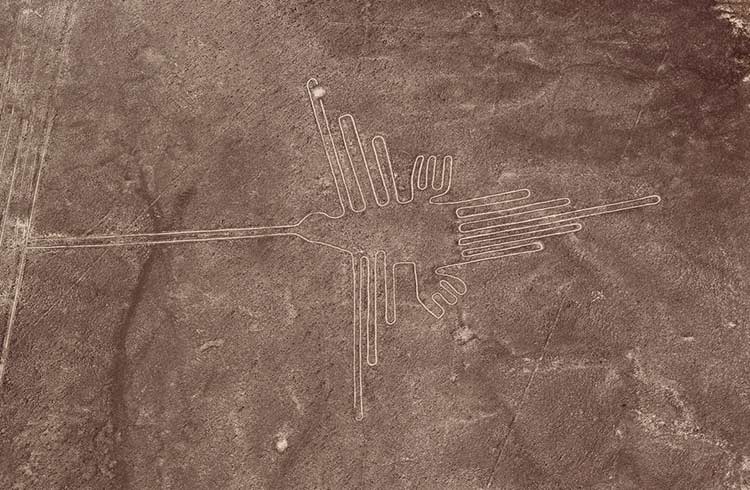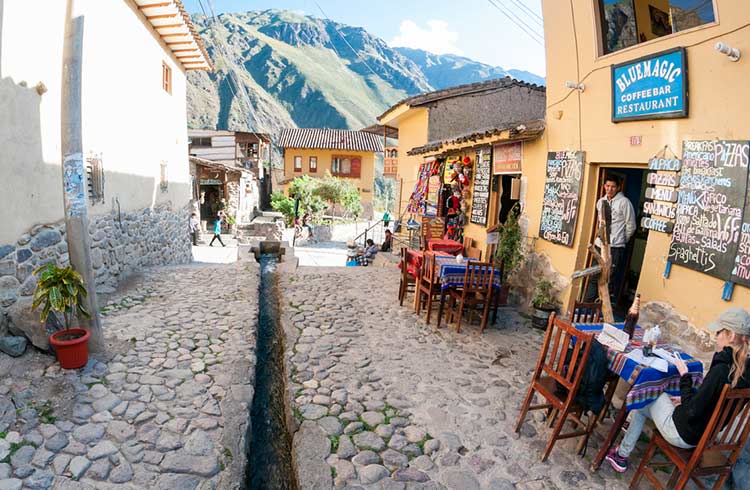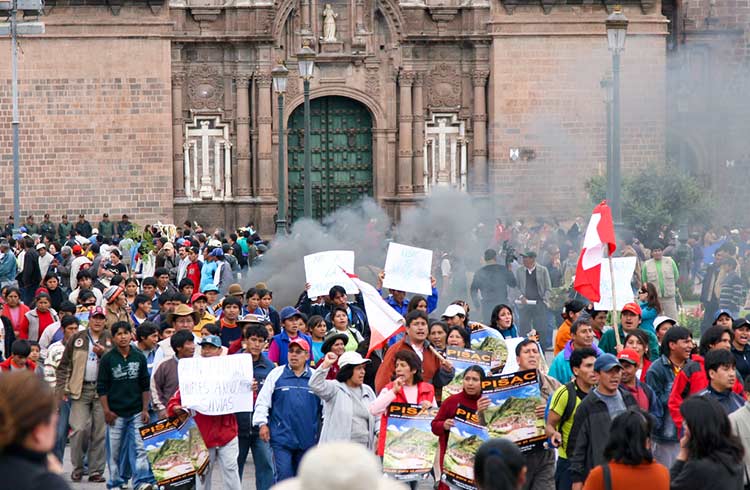Are the Nazca Lines Flights Safe? What You Need to Know
Coronavirus (COVID-19) and travel: The situation around the world is changing dramatically. Various governments have changed their travel warnings to restrict travel during this time. To understand how this may impact cover under your policy, please go to our FAQs and select your country of residence.
For the latest travel warnings and alerts around the world, read about lockdowns and border restrictions.
The World Heritage listed Nazca Lines are considered to be one of history's greatest mysteries. Find out about safe airlines, airsickness, and other options to see the sights.
Shares
 Photo © iStock/powerofforever
Photo © iStock/powerofforever
Whether you believe they're astronomical diagrams or alien runways, there's no denying Peru's Nazca Lines are an impressive sight.
The ancient designs have inspired hundreds of theories ranging from mundane to bizarre, earned a place in the UNESCO World Heritage List and drawn masses of visitors to the region each year.
More than 1,000 massive geoglyphs and nearly 50 biomorphs depicting plants, animals and humans are spread over 202mi (325km). With razor straight lines stretching over 7.4mi (11km), it is obvious the ancient artworks were made to be seen from the air.
In fact the lines were only rediscovered when the first commercial planes began passing overhead, so the resulting boom in charter flights seems only natural.
However a high number of accidents and tragedies indicate safety standards have not kept up with demand. Flight companies use planes that are almost as old as the Lines themselves and have a history of cutting corners on maintenance and preparation. So, just how safe is it to take a flight over the Nazca lines?
- Your life on the lines
- How do I pick a safe airline?
- Airsickness
- Can I see the lines from the ground?
Your life on the lines
When you take a flight over Nazca, you are literally putting your life on the Lines.
Six people were injured including four foreign tourists, after an Aero Palcazu flight crashed shortly after take off in 2015. Fortunately they were only 16ft in the air, and those on board sustained only minor injuries.
13 people were killed in accidents in 2010. There were many who survived with injuries and several close calls with emergency landings.
Following the air tragedies in 2010, the Peruvian government finally decided to enforce its zero tolerance policy, grounding all planes. After inspections, just seven of 48 planes were cleared to return to work.
Of the 14 companies that operated flights over Nazca, only four passed muster at the time. There are now strict rules in place governing the airlines across all aspects of operating flights.
While the number of incidents has dropped it is important to choose your flight operator wisely.
Obviously not everyone involved in flying planes over the Nazca Lines is acting irresponsibly. It is unlikely you'd be able to convince a pilot to knowingly risk their life by getting into an obviously faulty plane.
However, the workload on pilots is immense. They fly long hours and are often without a co-pilot, meaning they are simultaneously responsible for navigation, commentary and controls.
Limits on the number of planes allowed over the Lines also mean that companies are often forced to compromise safety standards in order to improve profit margins.
A 2008 survey showed 90 per cent of the planes at Nazca's Maria Reiche aerodrome were over 35 years old. While many of the older aircraft were permanently grounded in the 2010 government operation, there are still plenty of tired planes buzzing above Nazca. Old doesn't necessarily mean unsafe of course, but long service is rarely a bonus in aviation.
The sustained, steep curves the pilots use to show off the lines are tough on old fuel tanks. Centrifugal forces pull fuel away from intake lines, which can cause stalls. Cost-cutting measures mean planes are often flying on half-filled tanks or tanks filled with inferior fuel, which only makes matters worse.
There are even stories of pilots intentionally and illegally shutting off their engines and attempting to glide home in an effort to save fuel.
The bottom line is that out-dated equipment, competitive pressures and insufficient oversight make flying over Nazca a dangerous endeavour for tourists and pilots alike.
How do I pick a safe airline?
If you really want to see the designs from up high, there are a few considerations to take on board. As the Lines tend to overwhelm the other attractions in and around Nazca, most people only budget a very short amount of time in the area.
This, along with a huge number of tourists competing for each seat, leaves little room for you to be discerning about which company you use.
If you don't want to miss out and feel more comfortable pre-booking your flight, make sure to ask for the registration number of the plane you'll be going up in. You can plug this into any number of websites, like the Aviation Safety Network, to find out if the aircraft has a rough history.
Similarly, if you want do a little first hand investigation and book when you arrive, try to avoid handing over your money until you see the plane you'll be flying in. Do not be afraid to query the airline over its safety record and safety procedures for their flights.
Unpredictable weather, technical problems and high demand for a small number of working planes mean booking schedules are often thrown out the window. There seems to be little fidelity in the booking system as well, with some travellers reporting turning up early in the morning to snag a seat, while others who pre-booked say there were forced to wait for up to two days to finally get in the air.
Airsickness
One final consideration is that, in order to give both sides of the plane a fair look at the Lines, pilots will be performing a lot of steep banking, rolling the plane from side to side. Lots of patrons experience severe airsickness so make sure to take preventative measures or medication beforehand. If you're taking a risk on one of these flights you really don't want to spend the whole time peering into a plastic bag.
Pilots suggest taking flights early in the morning when turbulence is reduced and visibility is better.
Can I see the lines from the ground?
If you do decide to give the flights the flick, don't assume you should skip over the Nazca Valley entirely. You can still see a handful of the designs from El Mirador, a viewing platform next to the Pan American Highway.
The Aquaducts of Cantayoc are a powerful testament to the ingenuity of the Nazca as the Lines themselves. These spiral wells and irrigation channels brought life to the desert but are also thought to have been the focus of violent clashes and human sacrifices.
The Cementerio de Chauchilla is an eerie necropolis where perfectly preserved mummies rest above and below the desert sand. The site is protected but Peruvian grave robbers still manage to make a living fossicking through relics and remains and selling them on the black market.
If you've had enough of culture the towering dunes of Huacachina are great for high energy sandboarding and dune buggying while the oasis resort nestled beneath them offers plenty of places to relax.
Get a travel insurance quote for Peru
You can buy at home or while traveling, and claim online from anywhere in the world. With 150+ adventure activities covered and 24/7 emergency assistance.
Related articles
Simple and flexible travel insurance
You can buy at home or while traveling, and claim online from anywhere in the world. With 150+ adventure activities covered and 24/7 emergency assistance.
Get a quote

9 Comments
J would like to thank you for informative websites like these.... the plane crash picture you have on the site is the crash that took my sister away from me....people need to be much more aware of the cuts used to get planes in the air before the no fly time and the risks associated with that... especially because the government out there washes their hands of any involvement
Tracy,
I'm so sorry for you. Thank you for your support of what we're trying to do. Do you want me to remove that photograph?
Phil from the safety hub
Nice article, very informative and a bit worrying really. I first flew the lines without any real consideration to the thought of safety, but now working in the Peru travel industry, I feel it is an important factor that everyone flying the lines should serious consider. On average over the last 9 years more than 1 1/2 people per year have dies flying the lines!
Dear Sir,
I just had a fly over Nazca line last month(April 19,2015) and good luck that I and my 13 friends can see Nazca's lines and everythings as we expected to see , it's a very good time but one of my friend saw an aircraft who sleepy during his working , it's very dangerous and you should have him rest if he has to work for too many flight per day or stop to work if it was because his personality like that. I choose the flight company only by the cost, fortunately that it's work 555. But your country choose correct the problems and let the tourist know the truth and recheck and re certificate the aircraft every 6 months to 1 year. Another point that I would like to advise is that no need to swing the flight up and down to let all the tourists see the same Nazca's Line at the same timer. You may let the right side see first then turn back and let the other side see it all after. This option will reduce the airsickness people and reduce the accident during try to have them see the same Nazca'sLine at the same time. Thank you.
I was on one of these flights recently (September 2015) and would have to say it was the scariest flight I have ever been on. Shortly after takeoff all flights for the day were cancelled due to the weather turning bad, after experiencing extreme turbulence and attempting to land we were diverted to ICA. We had a poor girl in the back vomiting everywhere and the Co-Pilot was extremely stressed out, trying to call people for advise on the situation. From what I could tell the plane did not have GPS and the pilots just used the compass to point us in the right direction, we flew along the the highway (looking to land on it) and also the plane had some kind of terrain mapping and they were pointing and suggesting to land into the desert. Even landing in ICA was touch and go with the plane going almost vertical on our approach due to strong winds. I have never feared for my life as much as I did on that flight, I kissed my ass goodbye, If I had my chance again I would have never taken that flight. Pilots freaking out in spanish and not telling us anything. This is one story I wish I never had to tell.
My family just flew over the lines. We were ignorant of the danger, but we were in a very tiny plane and we were all sick and more than ready to return to the airport. We had a small child with us and had not read anything negative about taking him with us. We can see now that we were remiss in not doing some investigating. We should not assume that because they offer tours that it is safe. Thankfully, our plane had no problems and we had no after effects from the flight, but truthfully, we are glad we got to see the lines, but would never go again. It was not just the feeling of vomiting, but of coming close to passing out. We were all miserable and near the end of the tour, we could not even bear to look out the windows.
Having flown over in 2007 with family and friends, I strongly disagree with the recent tweet saying one of the best ways to enjoy the lines is from the air. There are several "movie theaters" in the Nazca town that will show you very nice videos of the lines.
The flight was really not a pleasure (because of the strong winds which are totally common there given it's close to the Pacific Coast and over a flat desert, and the pilot tilting the plane left and right to satisfy both rows of seats). Two results of the tilting is that, although you didn't eat anything in the morning (to avoid vomiting as they will suggest) *and* taking anti-illness pills, 4 of the 5 people we were still got sick and had to lay down for an hour after coming back, *and* (other result of tilting) that you can only see the lines very shortly (a few seconds at best). Hardly enough to understand their complexity. Of all the tourism I have made in Peru in several years, this was the single worst experience. The mirador and movies are both a much better use of your time and money.
People should be aware that booking with a particular airline may not, in fact, guarantee that you actually fly with that airline. For example, in these two blogs, https://www.gypsysoulimages.com/blog/2016/2/21/the-big-nazca-scam and http://freshcoffeestains.com/nazca-lines/, the writers booked with Movil Air but were shunted onto planes operated by Travel Air, with whom Movil Air apparently have an "arrangement". Travel Air have a poor safety record, with incidents in Feb 2009, Nov 2014, and most recently, Oct 2016 (see https://aviation-safety.net/wikibase/dblist2.php?at=&re=&pc=&op=&lo=&co=OB&ph=&na=&submit=Submit).
In that most recent incident, the Travel Air plane that crashed was even sporting Movil Air livery!
Movil air and Travel air belong to the same owner.